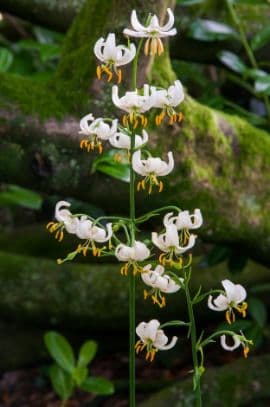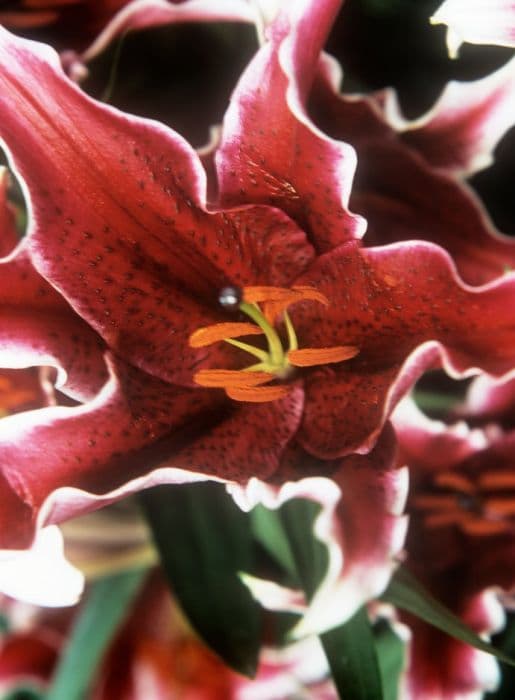Hemisphere Tulip Tulipa 'Hemisphere' (3)

ABOUT
Tulipa 'Hemisphere' is a stunning species within the tulip family known for its unique and vibrant blooms. The flowers of this tulip variety have a striking coloration, often displaying a beautiful mix of colors that can include shades of red, pink, white, and creamy yellow, with patterns that resemble brush strokes or splashes of color. Each petal is broad and somewhat ovate, coming to a slight point at the tip, which gives the flower its classic cup-like shape when fully opened. The petals may show a pleasing contrast with one base color and random streaks or blotches of another hue, making each flower look like an artist's palette. The leaves of the Tulipa 'Hemisphere' are equally attractive, being a rich green color and having a lanceolate shape, which means they are long and wider in the middle, tapering off towards the ends. They form a low clump at the base of the stem, providing a pleasant background to the colorful spectacle above. The stems themselves are sturdy, rising upright and holding the blooms aloft like natural bouquets. Overall, the appearance of Tulipa 'Hemisphere' is one of vibrant color and joyful spring energy, with each individual bloom offering a unique pattern that sets it apart from other tulips.
About this plant
 Names
NamesFamily
Liliaceae
Synonyms
Hemisphere Tulip
Common names
Tulipa 'Hemisphere'
 Toxicity
ToxicityTo humans
Tulip 'Hemisphere' contains allergenic lactones and other compounds that can be toxic if ingested, causing symptoms like vomiting, diarrhea, and dizziness. Handling the bulbs can also cause skin irritation in some people due to the presence of these compounds.
To pets
Tulip 'Hemisphere' is toxic to pets such as dogs and cats. If ingested, it can cause gastrointestinal upset, including vomiting and diarrhea. The most toxic part is the bulb, but all parts of the plant can be harmful if consumed in large quantities. In severe cases, it can lead to increased heart rate and changes in respiration.
 Characteristics
CharacteristicsLife cycle
Perennials
Foliage type
Deciduous
Color of leaves
Green
Flower color
Mixed
Height
1-2 feet (30-60 cm)
Spread
0-1 feet (0-30 cm)
Plant type
Bulb
Hardiness zones
3
Native area
Central Asia
Benefits
 General Benefits
General Benefits- Attracts Pollinators: The Tulip 'Hemisphere' provides nectar and pollen for bees and other beneficial insects, which is essential for pollination.
- Easy to Grow: This variety of tulip is known for being hardy and easy to cultivate, making it ideal for beginner gardeners.
- Spring Bloom: It produces vibrant flowers in the spring, offering a colorful display after the winter months.
- Aesthetic Appeal: The unique and varied patterns of the Tulip 'Hemisphere's' blooms add an aesthetic value to gardens and landscapes.
- Cutting Flower: These tulips are an excellent choice for cut flower arrangements as they have a good vase life, adding beauty indoors.
- Garden Design: They can be used effectively for border plantings, container gardening, and mass planting for visual impact.
- Variety: Offers a wide range of colors and patterns which allows for personalization of garden spaces.
 Medical Properties
Medical PropertiesThis plant is not used for medical purposes.
 Air-purifying Qualities
Air-purifying QualitiesThis plant is not specifically known for air purifying qualities.
 Other Uses
Other Uses- Tulip 'Hemisphere' petals can be used to create natural dyes for fabrics, offering hues from yellow to green depending on the mordants used.
- The bulbs of the tulip can serve as a replacement for onions in recipes when cooked, providing a sweeter and milder taste.
- Dried tulip petals can be incorporated into homemade potpourri mixtures to add color and a mild fragrance to a room.
- Tulip flowers can be used in floral art, such as Ikebana, the traditional Japanese art of flower arranging, for their vivid colors and distinct shapes.
- Petal of the tulip can be crystallized with egg whites and sugar to create delicate and edible decorations for desserts.
- The sturdy stems of tulips can be used in crafts for children, such as making flower puppets or as structural support in model making.
- Pressed tulip petals can be used in the art of decoupage to decorate objects like boxes, trays, or furniture, adding a natural touch to the items.
- The strong, clear colors of tulip petals make them a good choice for inclusion in stained glass-effect window art, using paper or translucent materials.
- Whole tulip blooms can be used to create elaborate garnishes for sophisticated culinary presentations in gourmet cooking.
- Extracts from tulip petals can be used as coloring agents in watercolor paints for artists seeking natural pigment options.
Interesting Facts
 Feng Shui
Feng ShuiThe Tulip is not commonly referenced in Feng Shui practice.
 Zodiac Sign Compitability
Zodiac Sign CompitabilityThe Tulip is not used in astrology practice.
 Plant Symbolism
Plant Symbolism- Perfect Love: Tulips often symbolize perfect, deep love. The 'Hemisphere' variety, with its unique and striking appearance, could represent a particularly distinctive or personal form of this profound emotion.
- Renewal: As harbingers of spring, tulips signify renewal and the coming of better times. The 'Hemisphere' can herald a personal or shared rejuvenation.
- Forgiveness: With its elegant and tender petals, Tulips can also symbolize forgiveness, extending an olive branch in a personal relationship.
- Charity: The tulip's generous bloom can embody acts of charity; the 'Hemisphere’, with its bountiful and open petals, can be particularly evocative of generosity of spirit.
- Royalty: In some cultures, especially considering its history during the tulip mania, the tulip can represent royalty or a regal bearing, and the 'Hemisphere' could translate as an air of sophistication and regality.
 Water
WaterFor Tulip 'Hemisphere,' it's essential to ensure the soil is moist but not waterlogged. During the growing season, typically spring, water these tulips when the top inch of soil feels dry, which could be about once a week. Use about 1/2 gallon of water per plant each time you water. After they have bloomed and the leaves begin to yellow, gradually reduce watering as the bulb goes dormant, especially if rainfall provides natural irrigation. Overwatering can cause bulb rot, so it's important to have well-draining soil.
 Light
LightThe Tulip 'Hemisphere' thrives in full sun to partial shade. They perform best when they receive at least six hours of direct sunlight each day. Plant them in a spot where morning sunlight is abundant, and some afternoon shade can protect them from the hottest part of the day.
 Temperature
TemperatureTulip 'Hemisphere' prefers a temperate climate with cold winters, as the bulbs require a chilling period to bloom effectively. The bulbs can survive winter temperatures down to about 14 degrees Fahrenheit and are hardy in USDA zones 3 through 8. The ideal temperature range for this tulip when in growth and bloom is between 40 and 70 degrees Fahrenheit.
 Pruning
PruningTulip 'Hemisphere' doesn't require traditional pruning; however, deadheading the spent flowers after blooming encourages the plant to put energy back into the bulb rather than seed production. Remove the flower heads but leave the foliage intact until it turns yellow and dies back naturally, which typically occurs by late spring or early summer. Cutting back the leaves too soon can weaken the bulb.
 Cleaning
CleaningAs needed
 Soil
SoilThe best soil mix for Tulips is well-draining, fertile, and neutral to slightly acidic with a pH of 6.0-7.0. A mixture of sandy loam enriched with compost or well-rotted manure is ideal to provide the necessary nutrients and drainage.
 Repotting
RepottingTulips, being perennial bulbs, do not typically require repotting. Once planted outdoors, they can remain undisturbed for several years as long as they are in well-draining soil and the area does not become waterlogged.
 Humidity & Misting
Humidity & MistingTulips prefer dry conditions and do not require high humidity. They thrive in outdoor environments where the atmosphere is not excessively humid, benefitting from the natural fluctuation of humidity levels typical of temperate climates.
 Suitable locations
Suitable locationsIndoor
Grow Tulips indoors with bright, indirect light and cool temperatures.
Outdoor
Plant Tulips in fall, full sun to partial shade, and well-draining soil.
Hardiness zone
3-8 USDA
 Life cycle
Life cycleTulipa 'Hemisphere', also known as the Hemisphere tulip, begins its life cycle when a tulip bulb is planted in the fall, several weeks before the ground freezes. The bulb undergoes a period of dormancy during the cold winter months, relying on the chill to trigger the biochemical processes necessary for spring growth. With the arrival of warmer temperatures and spring rains, the bulb breaks dormancy, and a shoot emerges from the soil, eventually producing leaves and a single, colorful flower. Once the tulip blooms, it attracts pollinators, which facilitate the reproduction process. Following the flowering stage, the petals eventually fall, and the plant redirects energy into the bulb for storage. As the foliage yellows and withers away by early summer, the bulb enters another period of dormancy, resting until the cycle restarts the following fall.
 Propogation
PropogationPropogation time
Spring
Tulipa 'Hemisphere', more commonly known as the Hemisphere tulip, is typically propagated through the division of its bulbs. The best time to propagate these tulips is in the fall, after the bulbs have completed their dormant period which usually happens after the foliage has died back. To propagate by division, carefully dig up the bulbs and gently separate the smaller bulblets from the parent bulb. These bulblets are essentially clones of the mother plant and can be replanted immediately at a depth of about 6 to 8 inches (15 to 20 cm) in well-draining soil with appropriate space to allow for root growth. It's important to make sure the pointed end of the bulb is facing upwards. After replanting, the new bulbs will establish themselves and should bloom in the following spring.






![Lily [Roselily Chelsea]](/_next/image?url=https%3A%2F%2Fplants-admin.emdemapps.com%2Fimages%2Fplants%2F%2Fimages%2F604b584f6f830.png&w=640&q=75)


